The pale green lichen and the dark green moss are what caught my eye, and then I thought, “Oh, this might be worthy of a #thicktrunktuesday post!”


The pale green lichen and the dark green moss are what caught my eye, and then I thought, “Oh, this might be worthy of a #thicktrunktuesday post!”

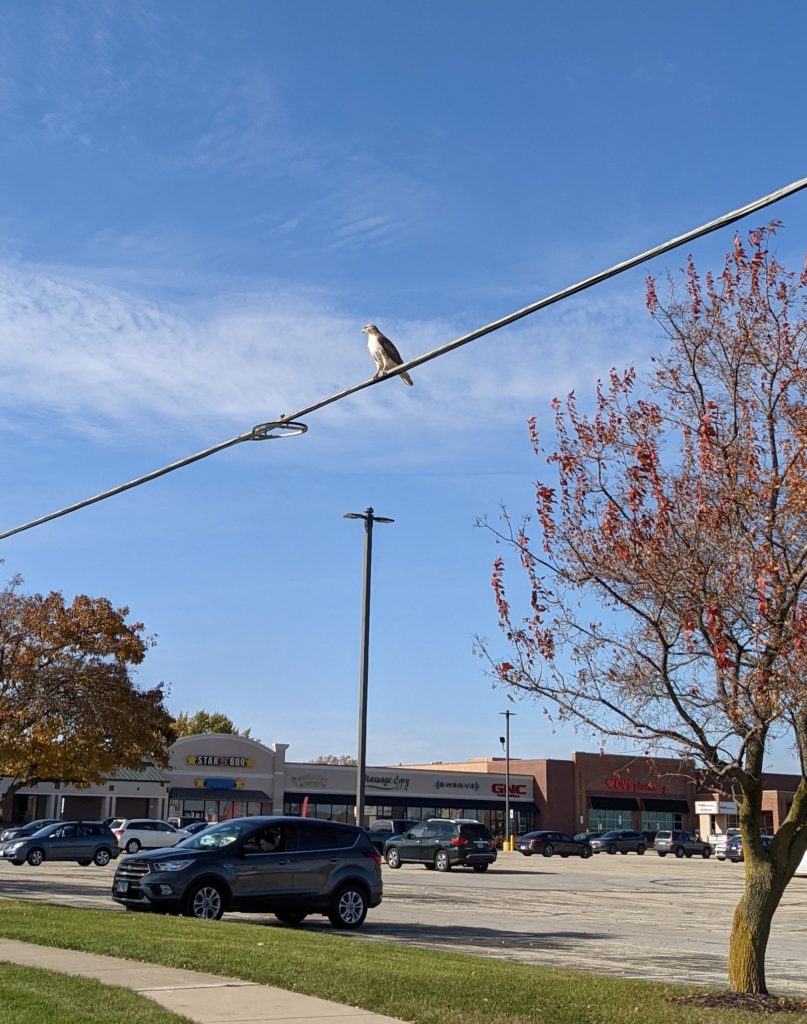
My workout was a medium-length run of 3.97 miles which I ran in 1:06:45, but that was not my only activity. Besides that, I also hiked a similar-length trail at Homer Lake with Jackie.
The walk was especially nice, and we’re very pleased that (with her new bionic hip) Jackie is once again able to walk reasonable distances. We walked about 2.72 miles in 1:24. There were some very nice views of Homer Lake, as well as some deer, some blue jays, and a handsome snek that I failed to get a decent picture of.
I did get a decent picture of Jackie:
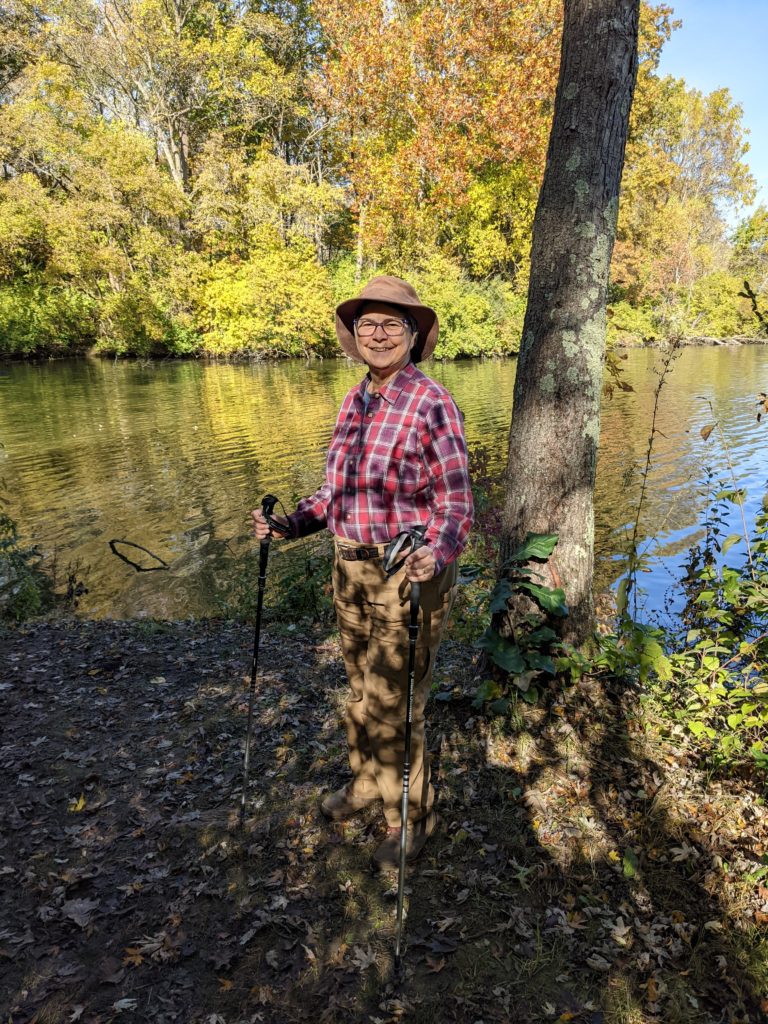
Besides the pictures from Homer Lake, I also got a picture of a handsome Red-tailed Hawk while I was out running, taken quite close to home. (See at the top of this post.) He was still there as I returned home.
I should mention that the run was actually quite a bit longer than my exercise-tracking app gave me credit for. (Google Fit estimates the distance at 4.46 miles.)
You can get an idea of just how much my exercise-tracking app shorted me from this map, if you know that I ran around the lake at the north end of of my run (and not as the map suggests, through it), and that I generally followed roads and paths (without cutting nearly as many corners as the map suggests).
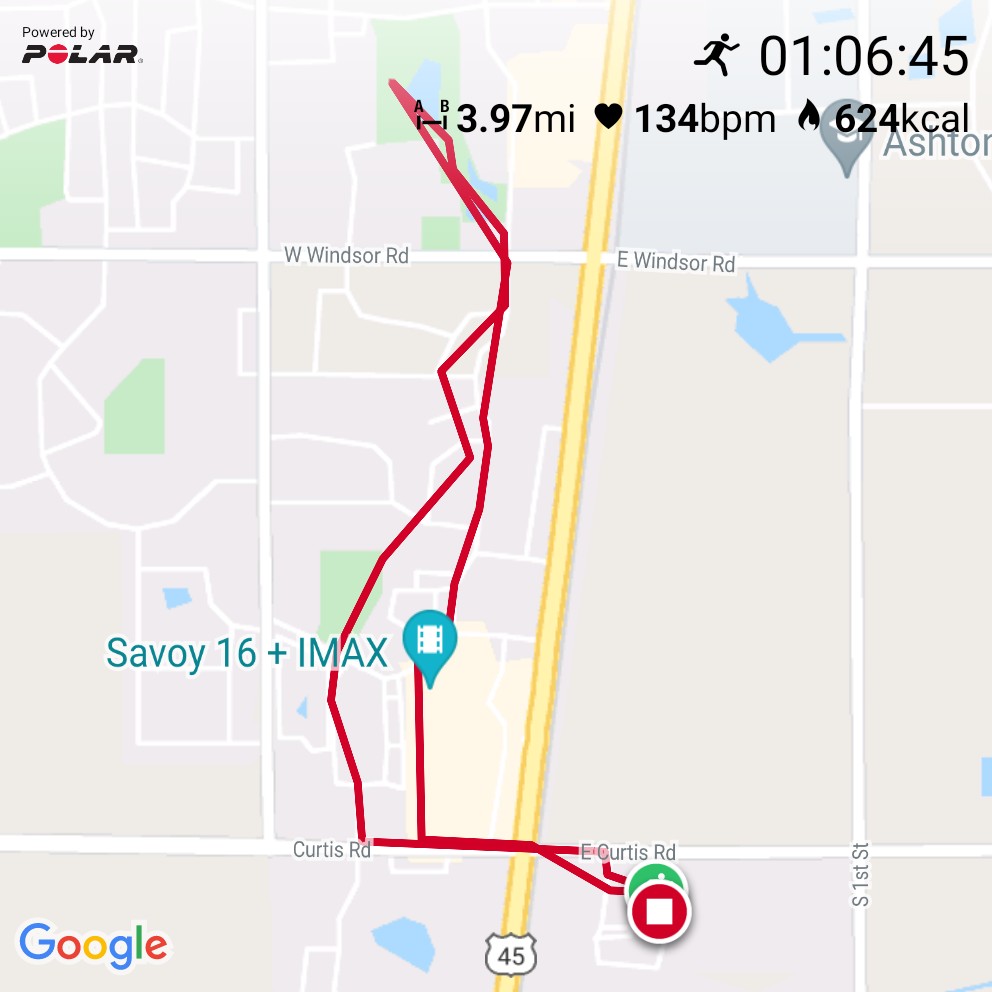
I want to reassure people that I will not be posting all of my workouts going forward. I just wanted to post a representative strength training session and run, so that I’d have then here as examples.
This year was obviously strange in all sorts of ways, so I figure it’s not so strange that my movement practice got strange.

One thing that seems very strange to me is that I reverted to doing a lot of exercise, after having made a big deal the past few years of scorning exercise in favor of movement. I wrote a whole post on this recently (Exercise, movement, training), so I won’t repeat all that stuff here, except to say that the pandemic response provided me with a lot of opportunities to exercise, while restricting my opportunities to move and to train.
Around the beginning of the year I had a realization that what had held me back from achieving my fitness goals was not (as I had been supposing) a lack of intensity, but rather a lack of consistency. I responded by getting very serious of getting my workouts in, and was pretty pleased about having established a proper workout habit when just a few weeks later the pandemic led to our local fitness room being closed. I found this momentarily daunting.
As I’ve mentioned elsewhere, it was around this time I saw this hilarious tweet:
To which my response was “Challenge accepted!”
The biggest problem with losing access to the fitness room was losing access to the pull-up bar. I looked around for alternatives, found that gymnastic rings were available and affordable, and I ordered a pair.
Easily the best purchase I made last year.
The addition of gymnastic rings made for a big change in my exercise regimen. I use them for three exercises: pull ups, inverted rows, and dips. I had worked pretty hard on pull ups before, but upon getting the rings I redoubled my efforts. As far as inverted rows and dips, I had played around with both, but now I got serious.
I round out my upper-body exercises with push ups.
For lower-body exercises I experimented with a variety of possibilities: squats of various types, kettlebell swings, burpees, lunges, etc.
One milestone was achieving my first pull-up. Another was the first time I did two pull-ups. Later I manged (a couple of times) to do three pull-ups!
I just wrote about how kettlebell swings taught me something about the value of doing lots of reps. Based on that, for my indoor workouts (where it’s not handy to set up my rings), I’ve started doing more exercises for high reps. Not enough data yet to know how that’s going to work, but it seems like a valuable experiment.
For a long time—at least many months, maybe more than a year—I’d had a sore foot that got worse when I ran. I repeatedly cut back or eliminated runs, had my foot get better, and then had it start hurting again as soon as I started running again. This past summer I finally took a full month off from running, which seems to have been what my foot needed.
I’ve very gradually resumed running. For some weeks I kept my runs down around just one a week and just 2–2.5 miles. Then up to a 3–3.5 miles. I did one 4 mile run, which didn’t seem to cause any problems, but then I did a run of nearly 5 miles, which did make my foot sore the next day. I took a break until the pain was completely gone and eased back to 3–3.5 miles, and all seems well.
I’ve just started doing two runs per week, a “long” run (slightly over 3 miles) and a “fast” run (where I hold the distance down under 3 miles, but include a few 10-second sprints around the mid-point of the run). That felt really good the last time I did it. (My running gait seems to improve when I run fast.)
I’ve talked at some length about my adventures in getting a kettlebell during a pandemic, and about my experience with kettlebell swings producing unexpected hypertrophy, so I won’t repeat that here. I’ll just say that cold weather—and especially ice on the patio—have kept me from doing much kettlebell swinging in the second half of December. But literally every day I look out on the patio to see if it is clear of ice, and get out and do some swinging when it seems safe.
I added a jump rope to my exercise equipment a while ago, and back in March and April did enough rope skipping to recover the ability to do it. (That is, I could jump rope for 30 or 40 seconds with zero or one misses.) The problem was that jumping rope hurt my sore foot just like running did. I prefer running, so when I had to set limits on those exercises to protect my feet, I ended up mostly running, as long as the weather was nice.
As the weather turned chilly in the fall, and especially when we started having days when there was an occasional short period adequate weather, but not the sort of reliable block of nice weather that makes me think I can fit in a good long run, I started thinking that an occasional bout of jumping rope might be a great way to squeeze in a quick, intense workout during even quite a brief period of nice weather on an otherwise nasty day.
To make full use of such periods, I paid up for a weighted jump rope. I have to say I’m pretty happy with it. It’s very much the opposite of my old jump rope, which was just a plastic-coated wire—very light and very fast—marketed to martial artists and cross-fit types. Pretty good for getting lighter on your feet, and adequate for a lower-body workout, but not much for the upper body. The weighted jump rope (even the lightest one, at just ¼ lb) definitely turns the jump rope exercise into an upper-body exercise as well.
I haven’t had the weighted jump rope long enough to form a definite opinion about it, but after just a couple of sessions, I’m pretty pleased, and if the weather cooperates, I’m hoping to get multiple HIIT jump rope workouts in over the course of the winter.
My main non-exercise movement is and always has been walking, but I’ve done very little this past year. This was half due to the pandemic, and half due to Jackie having a sore hip that makes it hard for her to walk fast or for long distances. (I’ve been taking Jackie to physical therapy, and she’s getting better. We’ve been doing walks in the woods south of the Arboretum, and that’s going very well.)
With fewer and shorter walks with Jackie, and with walking for transportation almost eliminated by the pandemic, my non-exercise walking has dwindled pretty severely.
Ditto for my non-exercise running.
I have very much had my eye on parkour as the thing I want to get back to this summer. Since I have made great progress on strength training specifically with an eye toward parkour, I’m very hopeful.
I’ve been doing just a bit of training, even without being able to get together with other traceurs.
The most active member of the campus parkour group turns out to have moved to Colorado. I’ve been in touch with him, and he seems to mean to spend at least some time here this summer, so hopefully I can put together some sort of training with him. In the meantime, I ordered one of his t-shirts, so I’ll have something to wear.
Like everything else, the taiji classes I used to teach at the Savoy Rec Center had to be abruptly canceled back in March.
During the spring I led a few group practice sessions via Zoom. They’re better than nothing, and at least keep the group connected.
Once the lock-down restrictions in Illinois eased up a bit in April, my group started meeting in the park, and we continued to meet through the summer. Once the weather turned, I resumed the on-line practice sessions.
Unlike a lot of my students, who don’t feel like they can do the taiji practice without someone to lead them, I can actually do a full practice session entirely on my own. And I occasionally do. But without the group being there, it’s hard to get motivated.
Still, I almost always include some qigong as part of my morning exercises, do the once-a-week group practice session, and occasionally do the full 48-movement form (if only to make sure I don’t forget how to do it).
Looking ahead, of course, is all about the end to the pandemic, something that I have high hopes for. If I can get vaccinated by June, let’s say, then by July maybe I can resume normal activity (while wearing a mask and maintaining social distance, of course, but actually interacting with people other than just Jackie).
Normal would include hiking in the woods, and maybe visiting some natural areas within a few hours drive. (We’ve pretty much completely avoided going anywhere so far that we couldn’t go, hike, and return without having to use a restroom.)
Normal would include practicing parkour with the campus group.
Normal would include resuming teaching taiji in the fall.
I had scheduled a visit to Urbana Boulders to do some wall climbing right when the lockdown started, so that fell by the wayside. I had actually started taking an aikido class when we had to stop because of the pandemic. Either one of those things might happen, once the pandemic ends.
Basically, I have high hopes for 2021.

I did an experiment a couple of days ago: I tested a combined workout that doubled up two pairs of exercises that I’d been doing separately. Up to now I’ve been doing four sessions each week: two where I do pull ups & pushups, and then two where I do dips & inverted rows. (Together with a leg exercise and a core exercise each workout.)
That was working very well, but it meant 4 upper-body strength sessions each week, which is a lot. Throw in a couple of lower-body strength sessions as well (such as hill sprints or kettlebell swings), plus a rest day, and I didn’t have a day to do anything else. This sort of volume has been well for me so far, but I think I may have reached a limit, and would benefit from a cycle of deeper recovery than just a week of lighter workouts: Except for “de-load” weeks in mid-March and mid-June, I’ve been averaging close to 5 workouts a week since the end of January. I’m thinking I want to take it down a notch.
With that in mind, I’ve been thinking about how I want to structure my training through the fall and winter. One obvious change was to go from four days of upper-body strength training per week to just three. The problem was that I didn’t see an easy way to evenly cover the range of pushing and pulling exercises at a reasonable volume with just three workouts a week, except by doing both pairs in each workout.
Hence my experiment, in which I did just that.
It was not a complete success. I managed to crank my way through the workout, but it was very long and tough. I don’t think I could keep it up three times a week for months.
Happily, while describing my difficulties to my friend Chuck, I had a brainstorm: I could do threes workouts per week—two of them just like what I’ve been doing (one with pull-ups & push-ups, and then another with inverted rows & dips), and then do just one combined workout. That keeps my workouts even, as far as covering all four exercises twice each week, without being quite so overwhelming as trying to do the combined workout three times a week.
With just three upper-body strength workouts per week, I have four days for other stuff, and I can mix and match as I choose. I can do the hill sprints that Anthony Arvanitakis recommends, or I can do kettlebell swings. (Either of those makes a good HIIT workout.) I can go for a run. I can go for a hike. I can do my animal moves. In particular, I can do two rest days, if that seems like a good idea. (Which I think it probably does. At least my Oura ring thinks so.)
This all got started back in February, when I figured out that I was lacking in consistency. (Previously I’d imagined that the problem was a lack of intensity.) Targeting 5 workouts a week has meant that, even when I miss one, I get in more than when I was targeting 3 workouts a week—even if I didn‘t miss one.
I don’t want to give up the consistency, I just want to take the volume down a notch. Hence the struggle. But I think now I’ve got a plan.
After walking at Allerton, we’ve stopped for lunch at @monarchbrewinco. I’m drinking their Wicked Pissah NE IPA and @jackieLbrewer has picked a selection from a brewery 50 miles south, the Effing Brew Tyrant’s Blood red rye IPA.
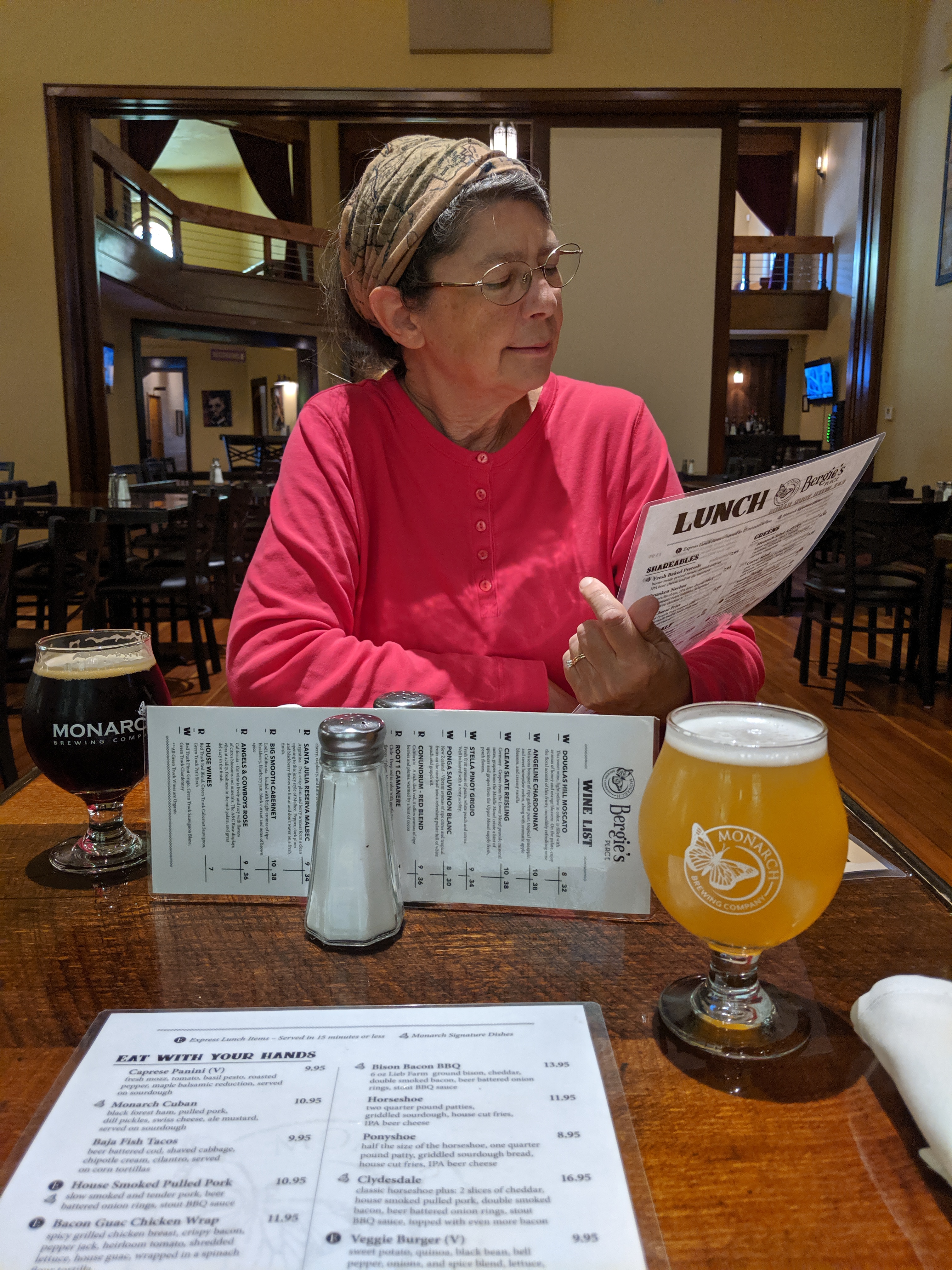
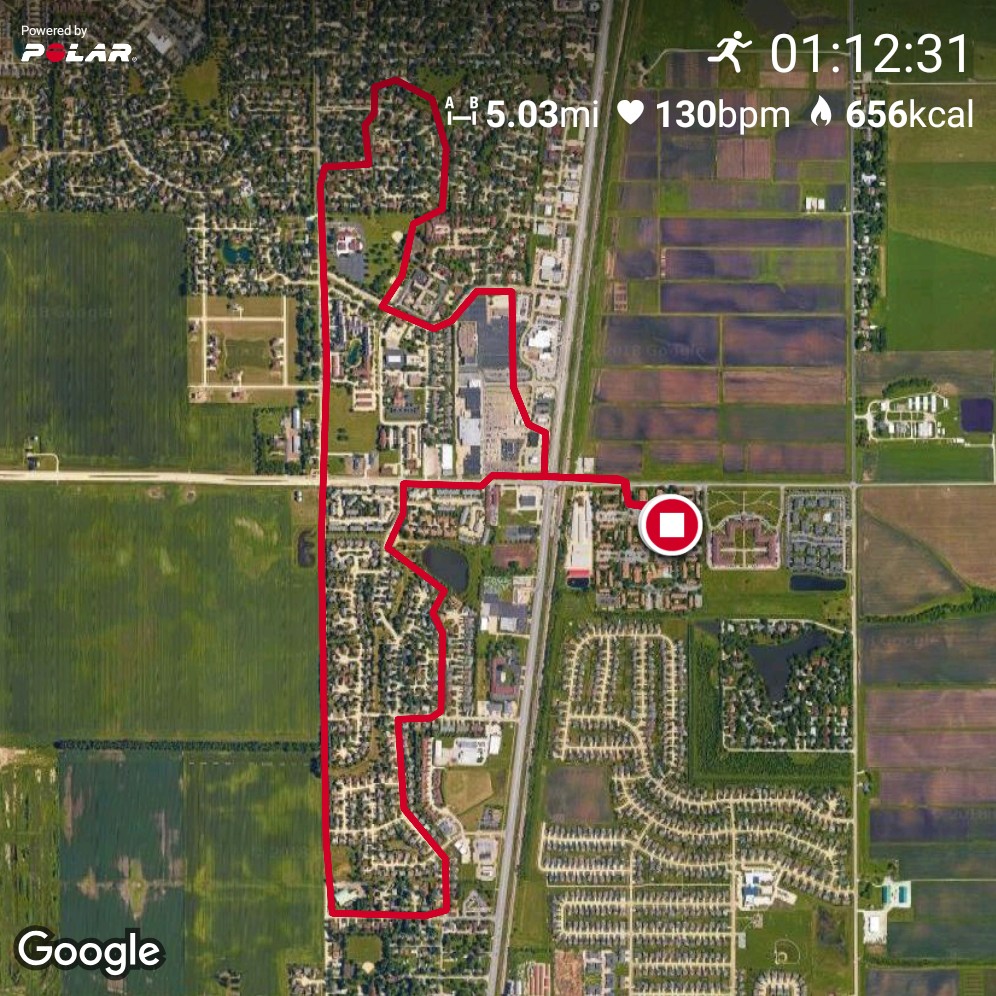
I have never been a winter runner. Most years I start running in the spring, ramp up the length of my long runs during the summer, make a plan to keep running through the fall, and then abandon it at the first sign of cold.
I’d like to run over the winter. Exercise helps as much as anything else I’ve tried to stave off SAD. Besides that, there are any number of spring running events that I’d enjoy participating in that I can never do because I’m not in shape until later in the year.
And so, demonstrating my unwillingness to learn from experience, I’m trying yet again to run over the winter.
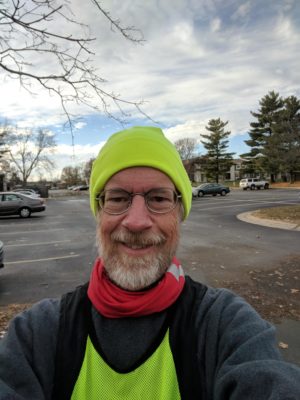
To help get myself started, I’ve embarked on a consumer binge. First I bought a high-viz hat. (I already had the high-viz running vest and the red buff with reflecty stripes.)
The hat got me out for a run or two.
Another garment that I didn’t really have was running tights. Having a pair of running tights, I figured, would eliminate one more excuse for skipping a run in the cold. Plus I was able to find a pair marked down from $80 to $20.
I wore the tights for a 5-mile Thanksgiving Day run. (See map at top.) That’s my longest run in a couple of years, and I felt great right along—no sore ankles, and no sore knees (the places that tend to hurt when I push the distance up too fast).
I did wake up this morning with sore feet—classic plantar fasciitis pain. My feet only hurt for a few minutes in the morning, which is typical with minor plantar fasciitis. I expect it will resolve itself in just a day or two, but even if it does, it’s a pretty strong indication that 5 miles is as far as I should run for a while. (I’d had no foot pain after my previous long run of 4 miles.)
To give my sore feet a break I didn’t run today, opting instead for a 3.2-mile hike at Homer Lake. The trails there are pretty flat and level, but there are some places with lots of tree roots right at the surface, which make for a nice complex surface to walk over, giving one a chance to mobilize the foot joints, highly beneficial for preventing plantar fasciitis.
I’ll post further winter running updates, if I manage to get the habit established this year.
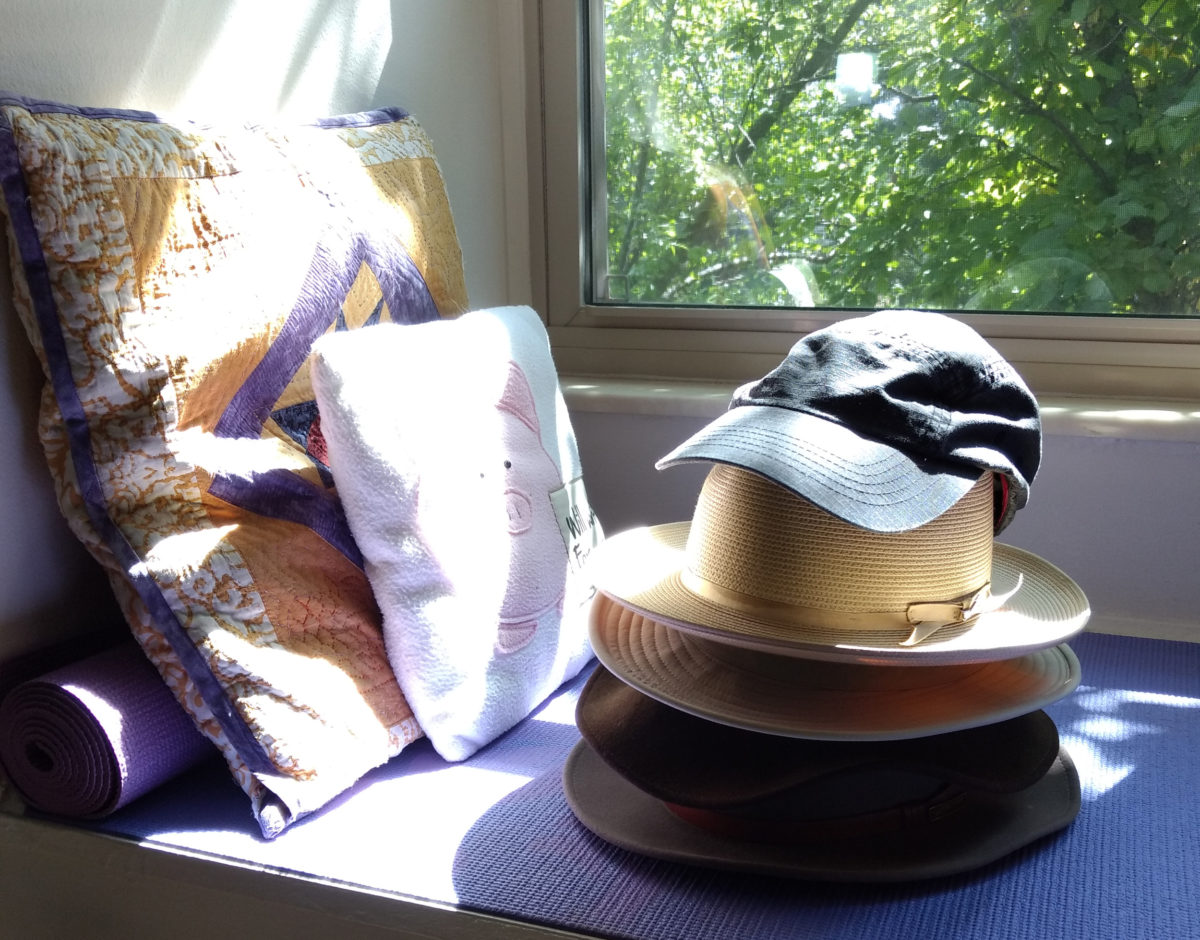
Years ago I had a panama hat that was great for hot sunny days. I think I still have it, but after a few years the straw cracked in the crown and I had to retire it from regular use.
For years I made do with felt hats, which are also great, but not ideal for hot, sunny days. So last summer I went to the local Rumours Hat Shoppe to look for a replacement panama hat, and found this hat—a panama hat as re-imagined by Stetson:
It’s a great hat, but it turns out not to be the right hat for hiking in the desert. (It’s more for sitting on the veranda and looking out over my plantation.)
In particular, the Stetson panama hat doesn’t have a cord to keep it on in the wind.
So, after a blustery day at Zion Canyon made me concerned about losing my hat, I visited an outfitters shop in Springdale and purchased a Tilley hat:
I’m simply delighted with this hat, which does have a cord, arranged so that it can go both behind the head and under the chin, but which can be easily tucked away inside the hat when it’s not windy.
Hopefully I am now all hatted up for years to come.
I’m pretty pleased with 2017 on a movement front. As I sat down to write this, I had been feeling a little discouraged about how slow my progress seemed on the strength front, but when I looked back at where I was one, two, and three years ago, I can see that I’m actually making steady progress. (And, after I’d started drafting this post, I managed to do a chin-up, so I’m especially pleased about that.)
I feel like I’ve pretty much managed to internalize my realization that movement trumps exercise. I certainly don’t move enough, but I’m much more inclined to notice now whenever I do something that minimizes or outsources my movement. This gives me a chance to say, “Never mind. I’ll go ahead and do that myself.”
Since I don’t move enough, I have to add exercise to the mix. Especially in the winter, when the cold and the dark and the ice make it tough to fit all the movement in, I exercise. And I pick my exercises with the goal of improving the capabilities—mobility (especially), strength, control and access to appropriate movement patterns—that I found were limiting factors last summer.
This last—access to movement patterns—is new. I’m just coming to realize that in many cases my limitations are not (or not entirely) a lack of strength or flexibility, but rather are due to poor patterning of the movement. More on that below.
I stuck with the exercises I’ve been focusing on for three years now, and added a couple.
I finally made real progress in squatting, and it turned out to be a really simple thing that made the difference—and probably a movement pattern thing.
In one of the classes I took with Ashley Price, she had us find the best squat we could do with perfect form. That is, we got in neutral posture with our feet hip width apart, our feet pointing straight forward, our femurs neutral, and then we squatted down only as far as we could go while keeping our shins vertical.
My discovery was that by first getting as far down as I could with my shins vertical, I was in a posture that let me easily lower down the rest of the way into a deep squat. It’s not a perfect deep squat (I wouldn’t want to load up my back with a heavy weight and lift it) and it’s not quite to where I can comfortably rest at the bottom of a deep squat (although it is getting pretty close), but it is now a useful capability. For example, on the last day of the year I got down in a deep squat to look over the choices in our liquor cabinet, and ended up lingering there for some little time. (The range of choices is rather large just now, thanks to a generous gift and a bit of splurging on our own.)
Basically, I’m happy with my progress on squatting.
Here I’m finally making great progress—chin-up!
Other than that I’m pretty much doing what I’ve been doing—negative pull-ups. Sometimes I do them for volume (I’ve done as much as 3 sets of 7, or 2 sets of 8 plus a few). Other times I’ve been doing many fewer sets and reps, concentrating instead on doing them very slowly.
Just since doing my chin-up I’ve begun to recognize a movement pattern issue here as well. Based on how sore my traps were after my first chin-up, while my lats weren’t sore at all, I think I’m failing to initiate the pull with my lats. I’m addressing that two ways. First, I’m doing the negative pull-ups very slowly, trying to find the point where I transition to using my lats and emphasize that part of the move. Second, I’m trying to specifically engage the lats by pulling my shoulders back and down before trying to pull myself up.
Besides all that I’m sticking with my other hanging exercises—swinging side-to-side and back-to-front, leg raises, knee-ups, and I’ve added some twisting knee-ups as well, turning my hips to alternate sides and raising my knees toward my elbow on that side. I’m also ready to start doing some traversals along the bar.
I haven’t made much progress here, for much the same reasons as last year: wall dips are hard, and I’ve been working on various progressions instead. I play around with bench dips and (rather shallow) parallel bar dips and wall supports.
Another reason I’m not making much progress here is that for my main pushing exercise I’ve been emphasizing pushups.
I’m reasonably pleased with my progress on toe flexibility as well, even though I haven’t actually increased my range of motion much. What I’ve done is improve my ankle dorsiflexion enough that I’ve been able to start doing the things I couldn’t do because of limited toe flexibility.
There’s a particular move I wanted to be able to do, that involved shifting from a squat to a deep knee bend, then lowering the knees to the ground and then kneeling. It can also be reversed by flexing the ankles to tuck the toes under, rocking back to get into a deep knee bend, and then shifting to a squat for standing back up.
Among other things, this is a martial arts move: You can move from kneeling to standing while keeping your hands free to block an attack (or prepare to launch one).
I can sorta do that now. Not smoothly, and not without an amount of toe stretching that feels a bit excessive, but vastly better than two years ago where a single attempt hurt my knees and toes enough that it took weeks to recover.
As I said, instead of dips I’ve instead been focusing on pushups. I’ve made good progress here as well: I can now do 8 pushups (up from 1 a little over a year ago). I’ve also greatly improved my form—keeping my elbows tucked in close to my sides, rather than letting them flair out as I’d probably done since I was a kid in gym class. (Your humeri should be neutral with your elbow pits pointed forward.)
Now that I can do 8 pushups it’s about time to start doing multiple sets—maybe starting with 2 sets of 5? I’ll try that in a couple of days.
I don’t have long-term plans to emphasize pushups though. I’ll keep doing them, but once I can do a couple of sets of pushups and still have some strength left in my triceps, I’ll get back to work on the various sorts of dips.
This year I added kettlebell swings to my exercise regimen. I want to talk about this a bit, because there’s a story here.
About a year and a half ago I was out on a very long walk with Jackie. Toward the end we sat down on some concrete benches for a short rest, and I found that there was an uncomfortable lump right behind where I was sitting. Shifting around to find a lumpless spot was not successful. Eventually I figured it out: I had lost enough weight that I no longer had enough cushioning to keep my tailbone up off the bench; the lump I felt was my coccyx.
Figuring that bigger glutes would be a better choice for keeping my coccyx up off the bench than fat anyway, I started boosting the weight I used in my goblet squats. Then I remembered an old post by Tim Ferris that recommended kettlebell swings as the best glute exercise. Then some anonymous kind soul donated a 45 lb kettlebell to the Winfield Village fitness room.
Looking at my training log, it appears that I started doing kettlebell swings in January, and worked up to 3 sets of 25 by April. As Tim had recommended 75 reps as a target, I’ve left it there. I don’t have data on the size of my glutes, but I’m no longer bothered when I sit on a hard bench.
I use the kettlebell swings as my high-intensity interval training as well. A set of 25 swings spikes my heart rate up right toward my max heart rate. (I’ve actually seen heart rates above my estimated max heart rate, which just means that the estimate is a bit off.) Each set takes about 50 seconds, and I follow it with as much rest as I need to get my heart rate back down around 100, which works out to two or three minutes.
I’ve toyed with the idea of adding a fourth set, and might yet do that.
My main non-exercise movement is and always has been walking. It was a bit limited in the second half of this year because I hurt my feet, and one foot in particular has taken a long time to recover.
I think what happened was this: I was waiting for the bus, which unbeknownst to me had been rerouted due to road construction. Seeing the bus zip past a block away, I took off running to try to catch it at the next stop. In the rush I think I must have fallen into an old heel-strike movement pattern, bruising my heels, resulting in this nagging foot pain. Only in the last few days of the year does it seem to finally be completely resolved.
I still walk a good bit for transportation, just less than I was doing before I hurt my feet. I’ve also done less walking with Jackie since she started working at Great Harvest bakery. (This does not mean less walking for her—she walks to work most days.)
I expect my walking quantity to return to its old baseline quantities in the new year.
Running was also curtailed by my foot injury. Before I hurt my foot I had been increasing my running distances as well, working my way up to where I did an 8-mile run for the first time in many years.
Some of my running is exercise, but a good bit is movement (as, for example, the sprint to catch the bus where I injured my feet.)
I did spend a little time with the campus parkour club, but once again timidity (both movement timidity and social timidity) kept me from doing as much as I might have.
Each summer I mean to step this up. Maybe 2018 will be the year.
For most of the year I teach two taiji classes—a beginners class that meets for an hour twice a week, and a group practice for continuing students (we don’t consider ourselves “advanced”) that meets for an hour three times a week. Besides that I do some taiji and qigong throughout most days. I do some qigong to loosen up in the morning. I do some before lifting to warm up, and then I do some between sets as “active recovery.” I might do a whole short form when I feel like a little moving mediation would do me some good, or even a whole long form when I feel like a lot of moving meditation would do me some good.
Basically, I do a lot of taiji.
Even when I’m not teaching I include it as part of my daily movement, simply because it has proven itself such a powerful tool for helping me move and feel better.
Over the summer I got back together with my friends who practice push hands a few times, but we were never able to get a regular thing going, which is very sad. I’ll try again next summer.
I have continued my practice of joining Jackie for occasional stewardship work days at natural areas in and around Urbana. (I even did one without Jackie—a prairie burn.)
These are perfect examples of non-exercise movement: We don’t do them for the exercise (although we get plenty); we do them to improve the land.
They are very satisfying for many reasons—doing hard work with friends is always satisfying, contributing to the community (making the parks better) doubly so. I think an additional reason is that the actual physical movements and mental activity that we do while locating and removing invasive plants is virtually identical to those that our hunting-and-gathering ancestors must have done for most of the past two hundred thousand years. (I see now that I made exactly the same point last year.)
With one possible exception, my plans for the new year don’t include big changes, just continuing progress. (The possible exception is treating myself to a month pass to Urbana Boulders and putting my new upper-body strength to work climbing walls.)
I have had some success in getting my mind right with the cold, this year in particular, but also gradually over the past several years. I’m getting in more outdoor exercise this year than last, and a lot more than I did five or ten years ago. That, plus the indoor strength training and the taiji, look to stand me in good stead for getting 2018 off to a good start.
We’re planning a spring trip to some national parks in southern Utah which will entail a good bit of walking, so we have that bit of extra motivation to keep up with our walking over the winter.
Happy New Year!
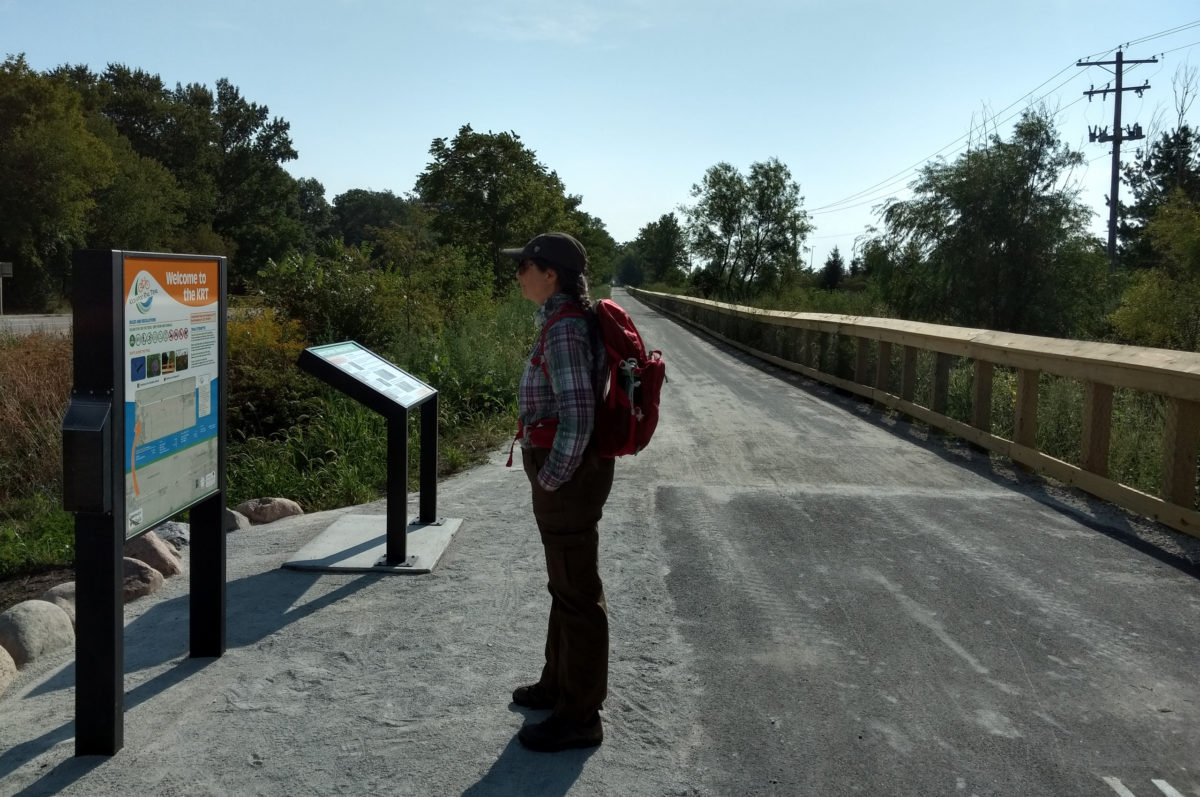
The Kickapoo Rail Trail had its ribbon-cutting Friday. Jackie and I attended as volunteers for the Champaign Forest Preserve District. We walked a short distance that evening, but our feet were tired after spending a couple of hours passing out flyers and listening to local dignitaries speak, so we cut that walk short.
We returned on Sunday to make a proper walk of it.
We parked at the Urbana WalMart (which has said that it’s okay for hikers and bikers to park there, as long as they park in the northwest corner, which is where you’d want to park anyway).
Then we hiked pretty much the whole trail: From High Cross Road to the end of the trail in St. Joseph and back again. We had lunch at the Wheelhouse, a pretty good restaurant in St. Joe that’s right there on the trail, and is appropriately cycling-themed. The only part of the trail that we didn’t hike is the short stretch west of High Cross Road that runs to Main Street where it nips up to University.
It’s a great trail. As Jackie and I discovered when we hiked the Kal-Haven trail, that crushed limestone is a great surface—hard enough for even a skinny-tired bicycle, soft enough to be gentle on feet that are going to be getting a pounding over a long hike, relatively cheap and easy to maintain.
There were a lot of cyclists out on the trail; they outnumbered the walkers by maybe 20 to 1. I guess that makes sense. The round trip is over 13 miles, which puts it up close to what I consider a very long walk (anything over 14 miles), but quite a modest distance for a bicyclist.
Sights along the trail include this spectacular view from the bridge over the Salt Fork:
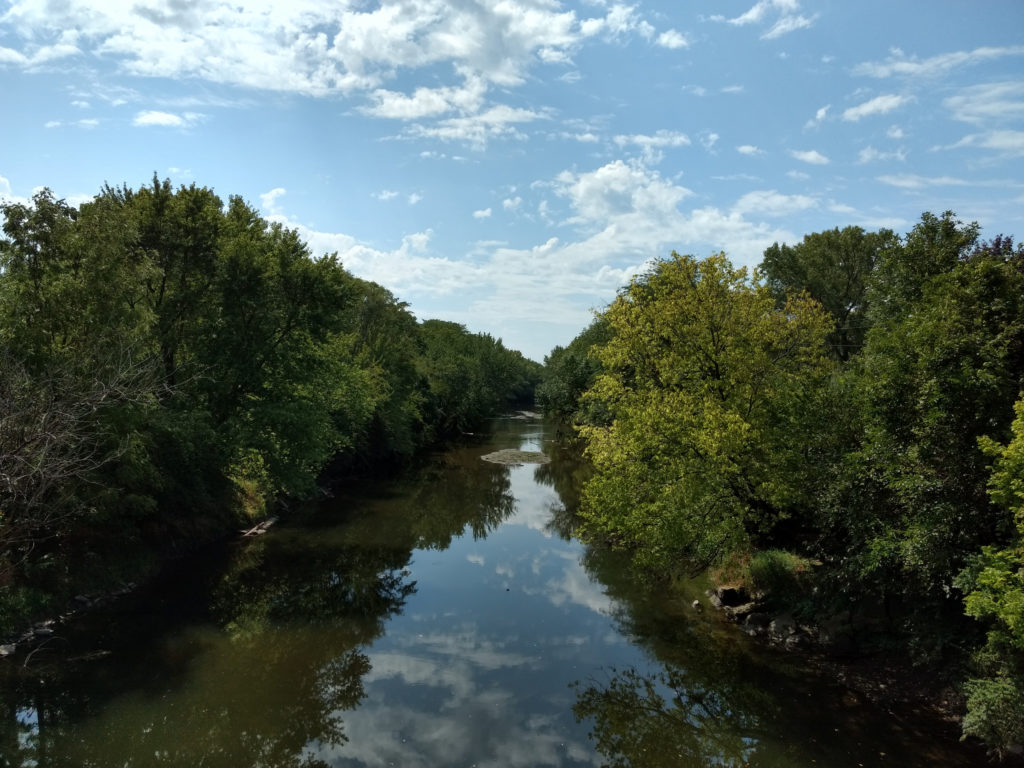
There are supposedly river otters along the Salt Fork now, according to the text on this sign, but we didn’t see any. (“They hide from you,” says my brother.)
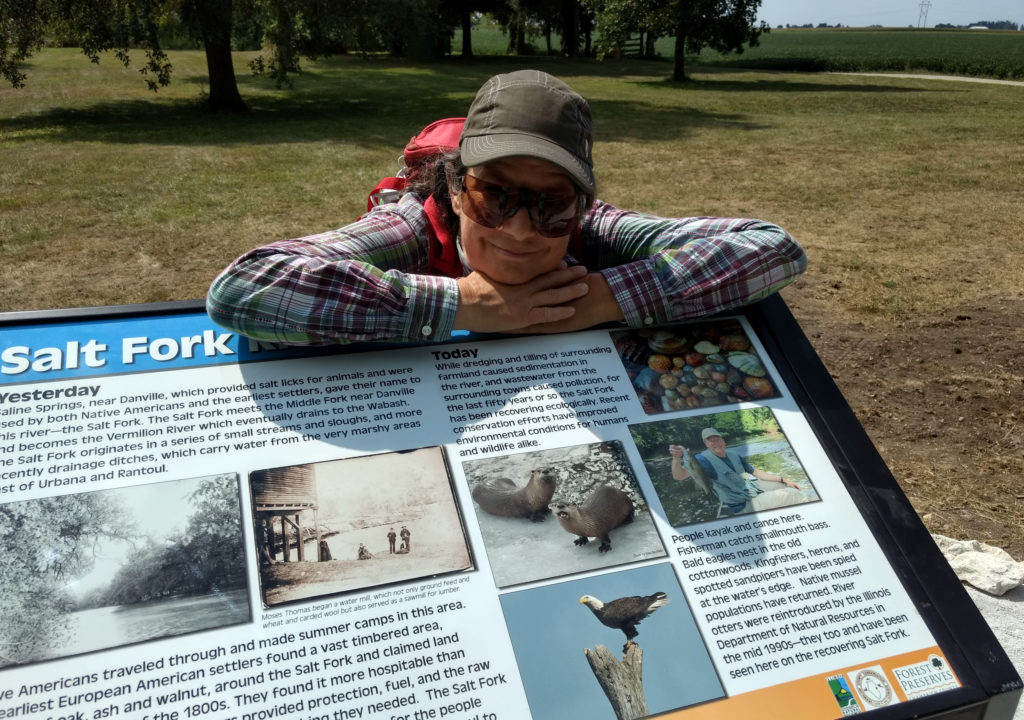
We will be back to bicycle the trail very soon. I don’t know if walking it will be a regular thing or not, but at a minimum we’ll get out to walk the stretch west of High Cross Road that we haven’t done yet.
My dad has fond memories of the old rail right-of-way from when he was a grad student (this would have been the late 1950s) and his advisor brought students out to there to see prairie remnants. Seeing this land properly preserved is wonderful, and I’m very much looking forward to the expansion of prairie species along the path that will follow with proper management.
We’re very excited about future plans for the trail. It’ll be years before it connects all the way to Danville, but there are bits that’ll probably get done sooner—trails heads at Weaver Park and Kolb Park, a short extension that will take it a few blocks further through St. Joseph (to the road to Homer Lake).
If you’re local, you should get out and bike or walk it at your next opportunity. It’s a wonderful trail.
A friend of mine posted to her Facebook page recently criticizing a whole category of ageist comments along the lines of “You’re only as old as you feel.”
It caught my interest in particular because I’d been mentally composing a post about how I just turned 58, but I’m not suffering the aches and pains that supposedly go along with getting old. My friend’s post reminded me that referring to this as “feeling young” is problematic. And yet, I find that I come down on the other side of this issue. Sure, there is a certain irrefutable accuracy to say that your age is the current year minus your birth year, but age is many things besides a mathematical calculation—at a minimum it’s a social construction, and also perhaps a collection of biological circumstances.
It’s true that what I mean—and what perhaps I should say—is I feel good. Better, in fact, than I’ve felt in years. I’m stronger, more flexible, and more agile than I’ve been in longer than I can remember. I move with more ease, more power, and more control. I have more endurance. I’m certainly more comfortable in my own skin.
A lot of this is just good luck, of course—good genes, avoiding serious injuries and serious illnesses so far.
Beyond good luck I credit my movement practice for most of the rest. Taiji. Walking and hiking. Running (merely an adjunct, but one I enjoy in particular). After years of lifting with machines to little noticeable effect I now do almost all my strength training with bodyweight exercises and am having much more success. (The main exception to pure bodyweight exercise is doing kettlebell swings for my high-intensity interval training, which I ought to write about because it seems to be doing some good, and is also quick and fun.) Push hands I wrote about recently. Animal movement ditto. So new I haven’t had a chance to write much about it yet, I did yoga for the first time last week.
But to bring this back full circle, I’m not so sure that it’s wrong to talk about “feeling young.” My friend is right—growing old is a privilege not everyone enjoys. It is indeed better than the alternative: dying young. But just as I can see her objections to denying age (as if refusing to acknowledge it meant something), I object to denying one’s felt experience. If someone says that they “feel young,” does an appeal to mere arithmetic justify correcting them?
Certainly I am not the only person to feel this way. There are always people trying to express health and fitness in terms of age. There are websites that will suggest a guess as to your physiological age vaguely based on your weight and your activity level. Various practitioners of various disciplines will measure specific things ranging from your maximum heart rate to the length of your telomeres and use the results to calculate a biological age.
They’re all pretty dubious, but I find that I do not object in principle to thinking and talking about concepts like health, fitness, and vitality in terms of age. Even though there are many unhealthy young people and many old people who are fit and vital, I think the notion resonates in a useful way.
As for me, I feel good. I also feel younger than I’ve felt in years.